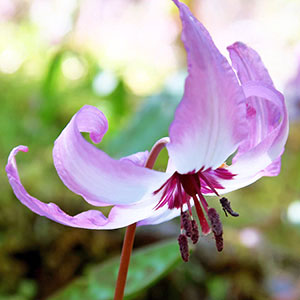Erythronium hendersonii
Erythronium albidum
Henderson's fawn-lily
white fawnlily, white trout-lily
slender, 40–55 mm.
ovoid, 15–30 mm;
stolons 1–3, mostly on 1-leaved, nonflowering plants; flowering plants reproducing vegetatively by offshoots or droppers.
10–25 cm;
blade mottled with irregular streaks of brown or white, oblong to ovate, margins entire to ± wavy.
8–22 cm;
blade green, irregularly mottled, elliptic-lanceolate to ovate-lanceolate or elliptic, ± flat, glaucous, margins entire.
reddish, 12–30 cm.
7–20 cm.
1–4-flowered.
1-flowered.
tepals violet to pink, darker at tips, dark purple at base, broadly lanceolate, 18–35 mm, inner with small auricles at base;
stamens 10–14 mm;
filaments violet-purple, linear, slender, less than 0.8 mm wide;
anthers pale brown to purple;
style violet, 6–8 mm;
stigma unlobed or with lobes shorter than 1 mm.
tepals strongly reflexed at anthesis, white, tinged pink, blue, or lavender abaxially, with yellow adaxial spot at base, lanceolate, 22–40 mm, auricles absent;
stamens 10–20 mm;
filaments yellow, lanceolate;
anthers yellow;
pollen yellow;
style white, 15–25 mm;
stigma lobes recurving, 1.5 mm.
obovoid, 2–4 cm.
held erect at maturity, obovoid, 10–22 mm, apex rounded to faintly apiculate or umbilicate.
= 24.
= 44.
Erythronium hendersonii
Erythronium albidum
Erythronium albidum often forms extensive colonies in which nonflowering, 1-leaved plants far outnumber flowering, 2-leaved ones. It is very widespread in eastern North America, more common in the central states than E. americanum and often occurs in slightly drier sites.
(Discussion copyrighted by Flora of North America; reprinted with permission.)
